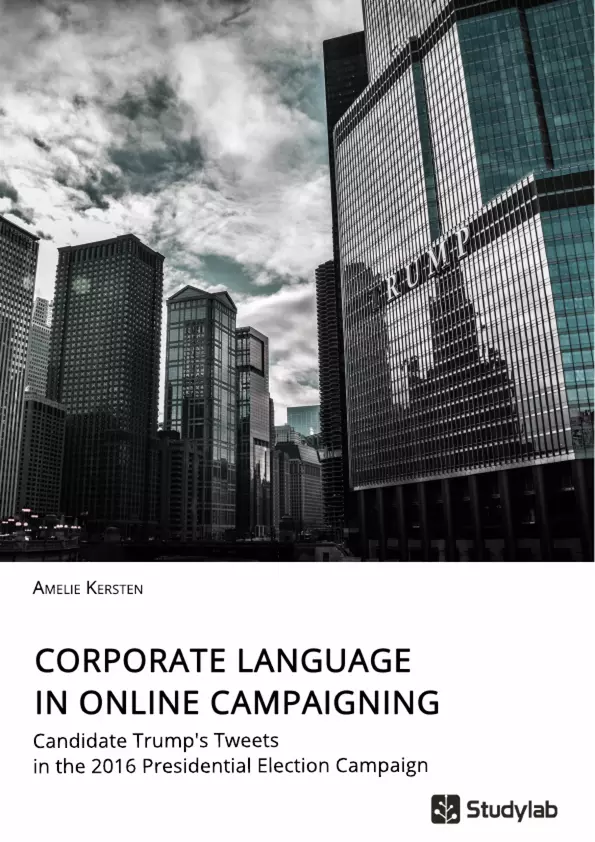Social Media has brought profound changes to the way people communicate with one another. The 2016 U.S. American presidential elections have demonstrated its deep impact on political participation. But still, only a small segment of research has focused on the actual content of tweets during election campaigns.
This is why Amelie Kersten explores Donald Trump’s preferred linguistic style within his presidential campaign. Did Trump use a simple marketing instrument called Corporate Language? Have all his tweets been written by himself?
By using a particular style in his tweets the former business man convinced voters to become his followers - not only in the digital world. Kersten shows that there are various linguistic patterns which point to a systematic use. In fact, the verbalization of Trump’s tweets can be generated through means such as reverse engineering.
In this book:
- Political Presidential Campaigning;
- Corporate Identity;
- Hillary Clinton;
- Twitter;
- Social Networks
Inhaltsverzeichnis (Table of Contents)
- Acknowledgement
- Abstract
- List of Figures
- List of Tables
- 1 Introduction
- 1.1 Aims of the thesis
- 1.2 Structure of the thesis
- 2 Political Context
- 2.1 The electoral system in the USA
- 2.2 Political Presidential Campaigning
- 2.3 Changes within Political Presidential Campaigning in thest century
- 2.4 The use of social media in Presidential Campaigning
- 2.4.1 Structure of Twitter
- 2.4.2 Criticism on Twitter in Political Campaigning
- 3 Corporate Language
- 3.1 Introduction
- 3.2 Implementation
- 3.3 Trump - A Corporate World
- 3.4 Previous Research
- 4 Methodology
- 4.1 Method of Data Collection
- 4.2 Method of Data Analysis
- 4.3 Limitations of the Study
- 5 Results
- 5.1 Presentation of Results
- 5.1.1 Quantitative Analysis
- 5.1.2 Qualitative Analysis
- 5.2 Discussion of Results
- 5.1 Presentation of Results
- 6 Conclusions and Future Work
Zielsetzung und Themenschwerpunkte (Objectives and Key Themes)
This thesis aims to explore whether Trump's preferred linguistic style within the presidential campaign was not only based on the simple marketing instrument Corporate Language but had also been created by an editorial team to frame authenticity. By using this particular style in his tweets, the former businessman convinced voters to become his follower - not only in the digital world.
- The impact of social media, particularly Twitter, on political campaigning.
- The use of Corporate Language as a linguistic strategy in political campaigning.
- The effectiveness of framing authenticity in political communication.
- The role of editorial teams in shaping political messaging.
- The influence of linguistic patterns and style on voter perception.
Zusammenfassung der Kapitel (Chapter Summaries)
Chapter 2 provides an overview of U.S. American election processes and its peculiarities. It delves into the concept of political campaigning, tracing its development from the origins to the present day, including the emergence of social media and its impact on political communication. Chapter 3 introduces Corporate Language as a marketing instrument, examining its application in brand building and customer engagement. It then explores the background of presidential candidate Trump and analyzes existing research on the use of social media in politics. Chapter 4 presents the methodology used for the content analysis of Trump's tweets, outlining the quantitative and qualitative approaches employed. It further discusses the limitations of the study. Chapter 5 presents and interprets the results of the analysis, examining both quantitative and qualitative findings. It analyzes the frequent use of specific terms, repetitive structures, and exchangeable emotional words in Trump's tweets, and explores the potential connections between these patterns and a unified Corporate Language strategy.
Schlüsselwörter (Keywords)
This study examines the use of Corporate Language in online political campaigning, specifically focusing on Donald Trump's tweets during the 2016 U.S. presidential election. It explores the relationship between linguistic patterns, social media, and political communication, examining how these elements contribute to the framing of authenticity and influence voter perception. Key concepts include Twitter, Corporate Language, social networks, political campaigning, Trump, stylometry, and sentiment analysis.
- Quote paper
- Amelie Kersten (Author), 2019, Corporate Language in Online Campaigning. Candidate Trump's Tweets in the 2016 Presidential Election Campaign, Munich, GRIN Verlag, https://www.grin.com/document/499466



